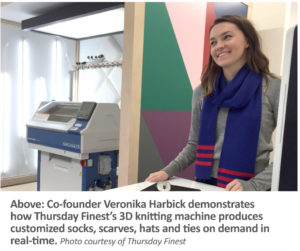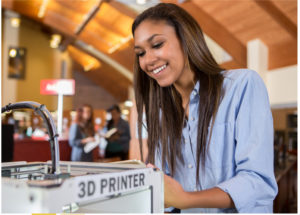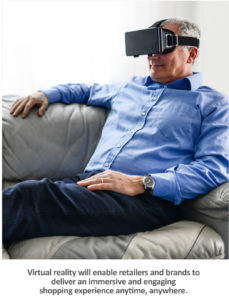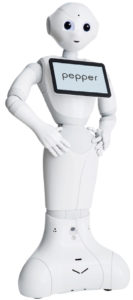Virtual reality, artificial intelligence, robotics, 3D printing and analytics—while those might sound like topics for a technology conference, they’re actually among the key drivers behind the ongoing transformation in retail. According to industry experts at the National Retail Federation’s BIG Show this year (one of the retail industry’s largest annual conventions), technology, data and insights are becoming ever more important to retailers and brands as they look for ways to keep up with the changing consumer.
If one thing is clear amongst all this change, it’s that the consumer is now in control. Retailers and brands can no longer dictate how, where and why consumers will shop. But with the help of innovative technologies, they can make strides toward harnessing the power of the consumer to build the store of the future.
On-Demand Retailing
 One forward-looking trend that can already be seen bubbling up in the retail space today is the concept of on-demand retailing. Several startups and innovative retailers and brands are beginning to capitalize on technologies like 3D printing, weaving and knitting machines to bring more personalized fashion to the masses in real-time. This is in sharp contrast to the typical model of fashion retailing, where products are designed and ordered months in advance based on retailers’ and brands’ own predictions of what consumers will want.
One forward-looking trend that can already be seen bubbling up in the retail space today is the concept of on-demand retailing. Several startups and innovative retailers and brands are beginning to capitalize on technologies like 3D printing, weaving and knitting machines to bring more personalized fashion to the masses in real-time. This is in sharp contrast to the typical model of fashion retailing, where products are designed and ordered months in advance based on retailers’ and brands’ own predictions of what consumers will want.
Thursday Finest, an e-commerce accessories company that’s using 3D knitting to create made-to-order socks, hats, scarves and ties, is one of the startups leading this trend. According to co-founder Veronika Harbick, the idea for their business was borne in part out of the frustration so many consumers experience with the typical shopping model.
“When we’re in the buying mindset, whether we’re going online or into a store, we usually have a sense of what we want,” she explains. “We know how we want it to fit us and what we want it to look like. A lot of times we find something that’s almost but not quite right, which leads to frustration. The ability to make customizations in things like size and color allows you to get what you first envisioned.”
 This idea of customizable, bespoke fashion isn’t new. But until now, it’s been reserved largely for the very rich—mainly because the fabrication and tailoring was done by hand. But as Thursday Finest is proving, automating the process has the ability to bring it mainstream. “You can do this at different qualities and on different scales, so pricing can be accessible and it can be available to everyone. It’s great for consumers, it’s great for business, and it’s great for the environment by not pre-making a lot of things in advance.”
This idea of customizable, bespoke fashion isn’t new. But until now, it’s been reserved largely for the very rich—mainly because the fabrication and tailoring was done by hand. But as Thursday Finest is proving, automating the process has the ability to bring it mainstream. “You can do this at different qualities and on different scales, so pricing can be accessible and it can be available to everyone. It’s great for consumers, it’s great for business, and it’s great for the environment by not pre-making a lot of things in advance.”
In Harbick’s estimation, this type of on-demand retailing will be one of the foundations of what consumers can expect from a store. “The store of the future will actually be the factory. You’ll be able to come in and get a body scan and have a garment made to fit your values, size and tastes right there in the store. It will create a reason to come into the store, while also making it a great and convenient experience.”
Predictive Personalization
Beyond being able to customize a product once you find it, technology innovations are also underway to help simplify and personalize the discovery process from the very beginning. Artificial intelligence (AI), big data and analytics in particular can combine to deliver highly-specific product and fit recommendations tailored to each unique shopper—not based simply on putting those shoppers into broad demographic categories, but actually pinpointed to the individual person’s values, tastes and preferences.
How does it work? Put simply, AI is any computer technology that can make “smart” decisions. Typically, AI systems work by using specialized algorithms (sets of coded rules) to comb through massive amounts of data in order to answer a particular question the user inputs. Fans of the television quiz show Jeopardy! may remember when a computer named “Watson” beat out previous champions in a head-to-head match-up several years ago. That was AI in action.
In the retail space, AI is already being used by several e-commerce retailers and brands to make product suggestions and fit recommendations. For example, Rocksbox, an e-commerce jewelry rental service, uses AI to comb through its over 5,000-piece inventory and choose three unique pieces to send to each subscriber every month. The system uses a trio of algorithms and 150 data points on each jewelry piece combined with user-provided answers about jewelry tastes and preferences. In a recent interview with the Chicago Tribune, CEO and founder Megan Rose said the AI system does a better job at choosing pieces that customers end up purchasing than human stylists can do alone.
E-commerce company Findmine is using AI to help other retailers and brands offer similar customized curation to their shoppers. The company’s “Complete the Look” technology builds personalized outfit recommendations based on items a shopper has already put in an online shopping cart. While currently used by e-commerce providers, the company says the technology could also be used on associate-run tablets, digital displays or even consumer’s mobile devices to transform the in-store shopping experience.
Improving Reality
 Further targeting both the in-store and e-commerce retailing are virtual and augmented reality. For those who aren’t familiar, virtual reality (VR) is technology that creates an immersive experience in a fully digital medium—almost like being inside a video game. Augmented reality (AR) overlays digital elements on the physical world, enhancing the experience.
Further targeting both the in-store and e-commerce retailing are virtual and augmented reality. For those who aren’t familiar, virtual reality (VR) is technology that creates an immersive experience in a fully digital medium—almost like being inside a video game. Augmented reality (AR) overlays digital elements on the physical world, enhancing the experience.
According to Neha Singh, co-founder of Obsess VR, a virtual reality platform for fashion retailers and brands, VR and AR have the potential to elevate and further blur the in-store and online shopping experiences.
“If you think about what high-end retail stores are like—the décor, the music, how products are placed—all combine to create a sensory experience. E-commerce today is missing that. But VR could give you almost all of that in the comfort of your home, combining the best of digital shopping with the physical store,” she explains.
Still, there will always be the desire to touch and try things on, says Singh, which means the physical store isn’t going anywhere. But the in-store experience could get an upgrade with the help of AR. Singh explains that as AR progresses from being a mobile technology to a wearable technology, it will become an important tool for mass merchandisers and other stores where convenience and efficiency is key. “For example, you’ll be able to use AR in the store to look for deals or find things quickly,” she says.
Robotic Retailing

Photo courtesy of SoftBank Robotics
Technology won’t just be the foundation behind the store of the future—it could also be the face of it. As robotic technology improves, some companies are testing the use of robots as customer service agents, in-store merchandizers and more.
One such robot already in use today is “Pepper,” a social humanoid robot made by Japanese technology company SoftBank. According to the company, Pepper is capable of understanding, interacting with and reacting to people in real-time. The model is currently being used in SoftBank and Nescafe stores in Japan today, acting as greeters, providing information about products and services and handling basic customer service questions. SoftBank says the aim is not to replace human store associates, but to allow them to focus on more valuable tasks.
This sentiment is echoed by other robotics firms targeting the retail space, such as Simbe Robotics—the maker of “Tally,” an autonomous inventory control and auditing robot. Tally is designed to help retailers keep track of the inventory they have on shelves and maintain planogram compliance to maximize sales, tasks that have typically been labor and cost intensive. In a recent press release, Simbe Robotics’ co-founder and CEO Brad Bogolea said using a robot like Tally could provide retailers with a more precise, timely and cost-effective analysis of the state of in-store merchandise, while freeing up staff to focus on customer service.
“The role of technology will rise for uses such as… robotics taking on roles of backroom inventory management, shelf management, floor stocking or checkout, or virtual recognition of the customer and their most recent shopping list—but none of this will completely replace the human interaction,” agrees Bharat Rupani, President of Retail Services for Daymon. Instead, he says, “retailers may find that using associates to truly provide services, subject or department expertise (think sommelier, baker, cheese monger, butcher) and experiences can be the differentiator” in the store of the future.
A New Vision of Retailing
Taken separately, these technologies could be seen as simply making tweaks to the existing shopping experience. But when combined, they stand to truly reinvent the concept of the store. “Brick-and-mortar stores, particularly higher-end stores, will become more about the experience instead of the transaction,” predicts Singh.
Rupani also emphasizes the importance of experience in stores of the future across channels and industries, including grocery. “Despite the excitement over Amazon Go or even unmanned stores such as Naraffar in Sweden, we believe the brick-and-mortar grocery store will continue to exist, but in a different form than today. Future stores will have a seamless blend of the physical experience with the digital to meet evolving consumer needs and lifestyles.”
He goes on to explain that in the grocery space, this may take the form of “personalization, customization, ‘grocerants’ [grocery stores/restaurants] or the creation of communal experiences. The store of the future may return in some form to days of past generations when shopping was a social experience—seeing neighbors and friends and sharing common interests. Flash forward and these ‘grocer-unities’ [grocery communities] are sharing the latest culinary innovations, environmental causes, mommy meal solutions and holistic health for seniors—all at a communal table in store!”
“The store of the future will be about creating a great experience that drives consumers to enter—allowing them to touch, feel and smell products in a way that you can’t do digitally,” agrees Harbick. “We’re going to make leaps in the flow of shopping, so it’s not just browsing aisles. The whole experience will be very tailored to [the individual shopper], based on data available. It’s going to be about providing something very special.” Retailers and brands that don’t step up to the challenge and innovate, she says, will be the ones that don’t survive.


